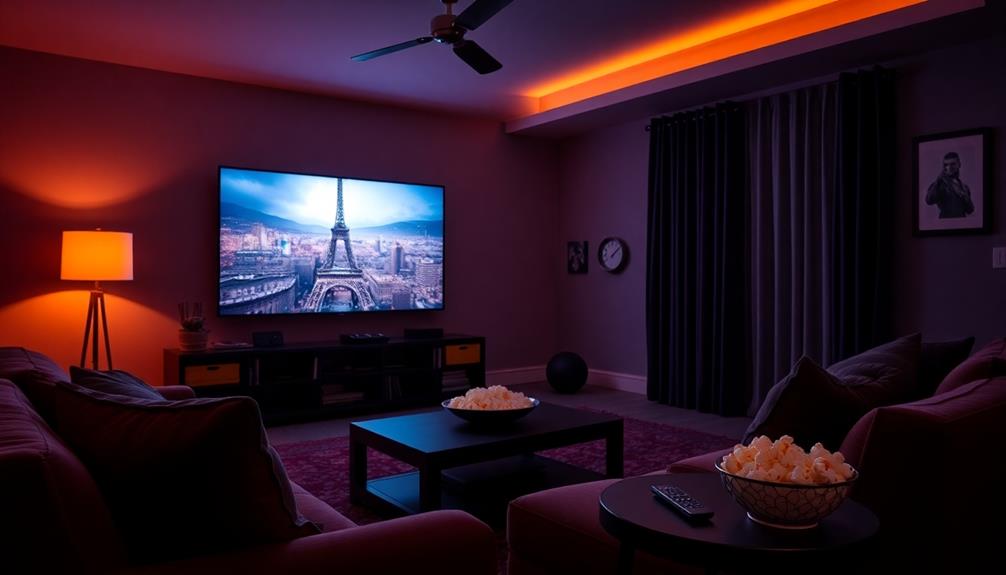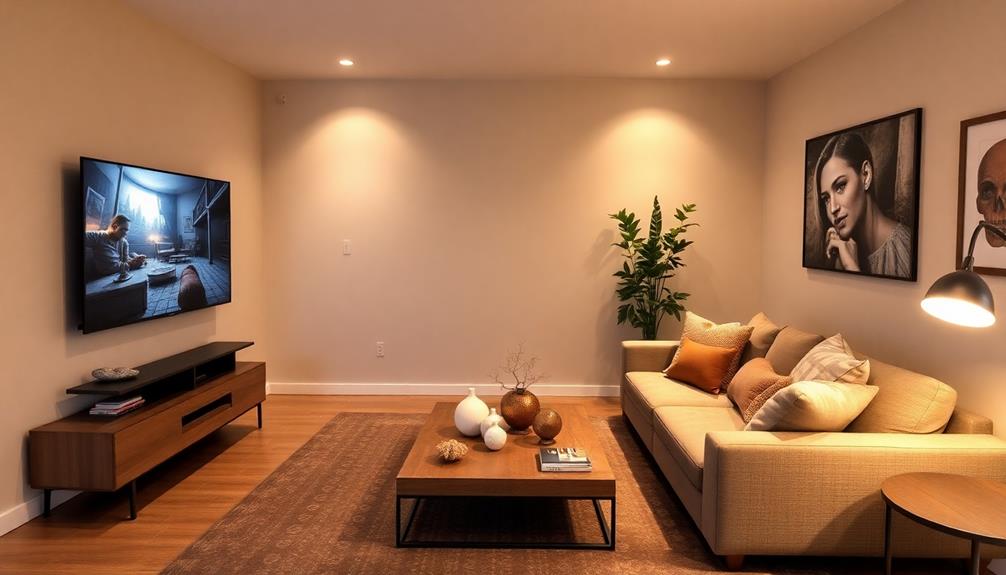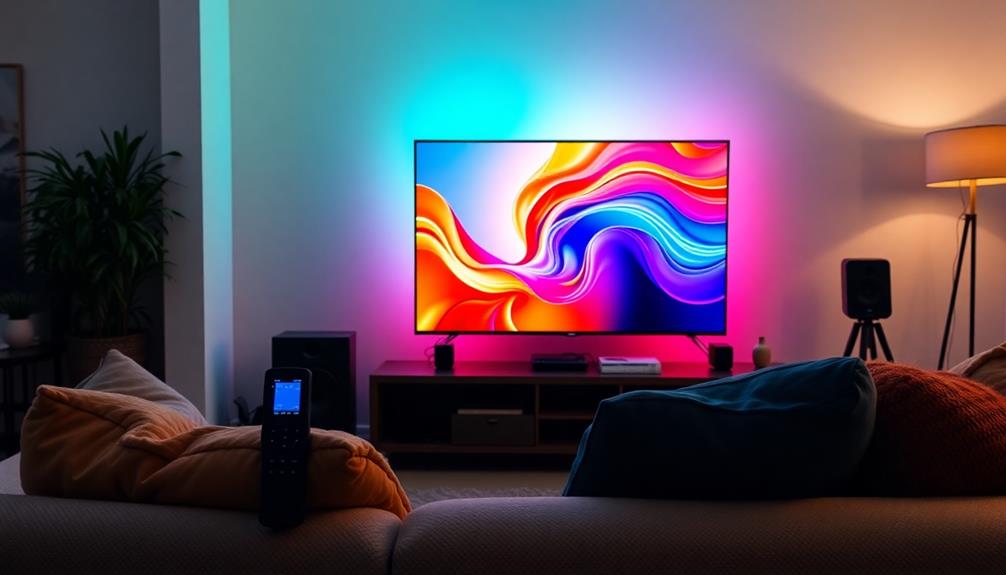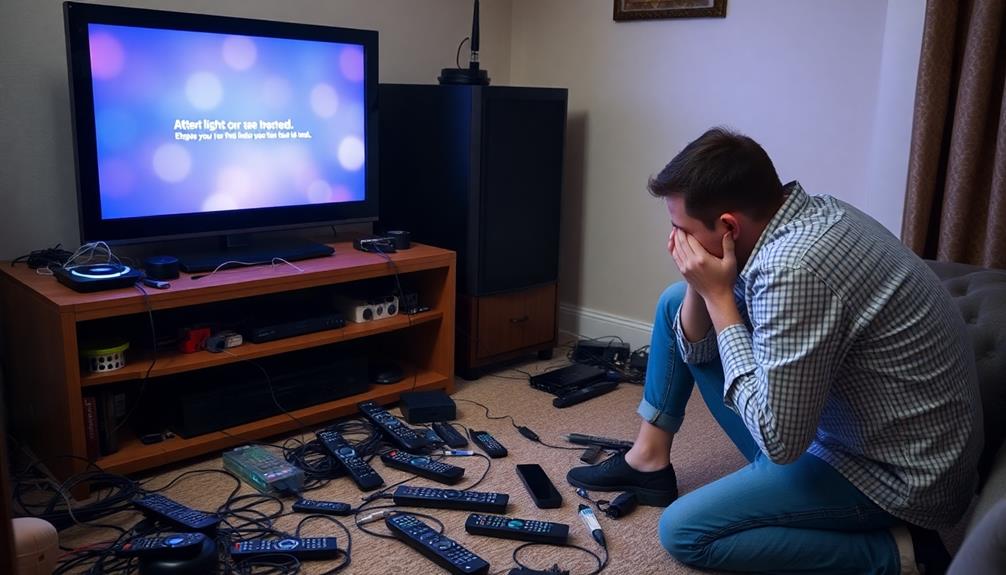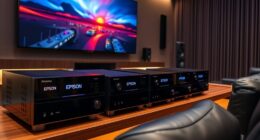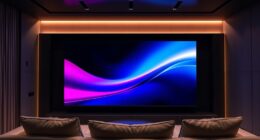To optimize your TV settings for movie watching, start by selecting the right picture mode, like Cinema or Filmmaker Mode. Adjust brightness and contrast based on your room's lighting, and keep sharpness low to avoid that artificial look. Make certain your color temperature is warm for accurate skin tones. Turn off motion smoothing to preserve the film's original frame rate and avoid the "soap opera effect." Finally, if your TV supports HDR, enable it for richer colors and better detail. By fine-tuning these settings, you'll enhance your movie experience considerably. There's so much more to explore to perfect your setup!
Key Takeaways
- Set your TV to Filmmaker Mode or Cinema Mode to preserve the director's intent and achieve accurate color representation.
- Adjust brightness and contrast based on your viewing environment to enhance details in both dark and bright scenes.
- Turn off motion smoothing to avoid the "soap opera effect" and maintain the film's original frame rate.
- Keep sharpness settings low (5% to 10%) to prevent artificial lines and maintain a natural appearance in images.
- Regularly recalibrate your settings and monitor firmware updates for improved picture quality and HDR capabilities.
Understanding Factory Picture Modes
Have you ever wondered why your TV has different picture modes? These factory picture modes—like Vivid, Cinema, Sports, and Filmmaker—are designed to optimize settings for various viewing experiences.
Vivid mode cranks up brightness and saturation, making images pop; however, this can lead to oversaturated colors and a loss of detail in darker scenes.
For movie watching, Cinema mode is often your best bet as it adjusts the color temperature to provide a warmer and more accurate representation of colors.
If you want to experience a film as the director intended, Filmmaker Mode is the way to go. This mode disables certain processing features, ensuring that the original frame rate and aspect ratio are preserved.
On the other hand, Sports mode enhances brightness and contrast to capture fast-paced action on-screen, but it isn't ideal for movies due to its excessive brightness, which can compromise picture quality.
Understanding these modes helps you choose the right one for your content, ensuring an enjoyable viewing experience tailored to your preferences.
Key Individual Settings Adjustments
Choosing the right picture mode is just the beginning; fine-tuning individual settings can greatly enhance your movie-watching experience.
Start with brightness; adjust it to reveal the depth in dark scenes without sacrificing contrast. Use dark scenes to calibrate this setting effectively.
Next, fine-tune the contrast to guarantee bright areas retain detail while avoiding washed-out highlights. Test images with both bright and dark sections can help you find the sweet spot.
For warm color temperature, aim for accurate skin tones and natural whites, steering clear of any blue tint that could detract from your viewing experience.
When it comes to sharpness, keep it low—ideally between 5% to 10%—to avoid artificial lines and noise, as true sharpness is determined by your source material.
Finally, choose Filmmaker Mode or Cinema Mode. These settings disable unnecessary processing, helping preserve the director's intent and delivering a superior picture with accurate colors and frame rates.
Importance of HDR for Movies
When you watch movies, HDR can greatly enhance color accuracy and expand the dynamic range, making every scene pop.
You'll notice richer details in both the shadows and highlights, creating a more immersive experience.
With HDR, films look closer to how the filmmakers intended, pulling you deeper into the story.
Enhanced Color Accuracy
Often overlooked, enhanced color accuracy through HDR (High Dynamic Range) can markedly transform your movie-watching experience. When you adjust your TV settings to incorporate HDR, you expand the dynamic range of brightness and color. This means you'll see more detail in both highlights and shadows, giving you a fuller, more immersive viewing experience.
To achieve ideal color saturation, verify your TV is in movie or cinema mode, as these settings are designed to provide the best visual results. HDR-capable TVs often automatically switch to HDR mode when they detect compatible content, so you don't have to worry about manually adjusting these settings.
However, fine-tuning your brightness setting and contrast control can enhance the impact even further.
Movies mastered in HDR, especially those using formats like Dolby Vision, take advantage of dynamic metadata, adjusting scene settings for the best viewing experience throughout the film. By utilizing HDR, you'll see bright specular highlights more vividly, reflecting the director's intent and enriching your overall movie experience.
Embrace these ideal settings for a cinematic journey that's as visually stunning as it's entertaining.
Dynamic Range Expansion
Dynamic range expansion through HDR (High Dynamic Range) is essential for anyone looking to elevate their movie-watching experience. HDR noticeably enhances the dynamic range, allowing for deeper blacks and brighter whites, which reveals more detail in both shadow and highlight areas. This creates a richer contrast ratio, making your movies look more lifelike.
Here's a quick comparison to illustrate the benefits of HDR:
| Aspect | Standard Dynamic Range | High Dynamic Range |
|---|---|---|
| Brightness | Limited | Expanded |
| Color Accuracy | Average | Enhanced |
| Detail in Shadows | Often Lost | Preserved |
| Immersive Experience | Moderate | Highly Immersive |
With HDR, bright highlights, like sunsets or explosions, become more vivid, enhancing your overall viewing experience. Modern HDR TVs automatically optimize picture settings when compatible content is detected, ensuring you get the best brightness and color accuracy without any hassle. Movies mastered in HDR, especially those featuring Dolby Vision, allow your TV to adjust settings dynamically, providing a more accurate portrayal of the filmmaker's intent. Embrace HDR for an unparalleled movie-watching journey!
Advanced Calibration Techniques
Although many TVs come with preset modes that enhance image quality, fine-tuning your settings through advanced calibration techniques can greatly elevate your movie-watching experience.
Start by adjusting the contrast settings to enhance the difference between light and dark areas in the image. Aim to discern various shades of white for ideal depth perception while preserving detail in highlights.
Next, focus on sharpness control. Setting it low, around 5% to 10%, prevents artificial lines and maintains a natural look.
For color calibration, utilize test patterns to achieve accurate saturation levels. While cinema modes typically provide ideal settings, manual tuning might be necessary to avoid over-saturation and achieve lifelike visuals.
Don't overlook tint adjustments, which are vital for balancing red and green hues. This step is essential for accurate skin tones and overall color balance, especially in movie or cinema mode.
Finally, using calibration discs or apps can greatly help you refine settings like brightness and contrast, creating a personalized viewing experience that matches your preferences and the content you're watching.
With these adjustments, you're well on your way to enjoying movies as they were meant to be seen.
Motion Smoothing: What to Know
Many viewers mightn't realize that motion smoothing, also known as frame interpolation, can greatly impact how movies are experienced. This feature adds extra frames to reduce motion blur, but it often alters the intended cinematic experience, especially for films shot at 24 frames per second (FPS).
You may notice a "soap opera effect," where movies look less natural and lose their artistic quality. To preserve the original frame rate and avoid artificial enhancements, it's recommended to disable motion smoothing.
Many TV brands have different names for this feature, like TruMotion on LG or Auto Motion Plus on Samsung, but the effect is similar across all. Turning off motion smoothing can restore the film's intended look, allowing you to fully appreciate the director's vision.
To disable motion smoothing, simply navigate through your TV's settings menu. This feature is commonly enabled by default when you purchase a new TV, so be sure to check it before starting your movie night.
Utilizing Filmmaker Mode
Filmmaker Mode is a game-changer for anyone serious about their movie-watching experience. With this setting, you can replicate the theatrical viewing style that directors intended by disabling post-processing features like motion smoothing and frame interpolation. This means you'll see the movie as it was meant to be seen, maintaining the original aspect ratio and frame rate.
Many modern TVs, including those from LG, Samsung, and Vizio, offer Filmmaker Mode as a dedicated picture setting for peak movie watching. When you activate it, you'll notice a warmer color temperature that enhances color accuracy and reduces the blue tint often found in other presets, like Vivid Mode.
To get the best results, you might need to adjust the brightness slightly, as Filmmaker Mode can appear darker in well-lit rooms. This minor tweak will help guarantee that the darker scenes still provide detail without losing the overall cinematic experience.
Color Temperature and Sharpness
Getting the color temperature and sharpness right can greatly enhance your movie-watching experience. To achieve the best results, consider these key adjustments:
- Set your color temperature to warm/low for accurate, natural-looking whites.
- Reduce sharpness control to between 5% and 10% to maintain a natural appearance.
- Aim for lifelike skin tones that enhance visual fidelity.
- Avoid excessive sharpness, which can distort details and detract from the filmmaker's intent.
By adjusting your TV settings, you can create a more immersive movie-watching environment. A proper color temperature setting not only makes skin tones appear more lifelike but also enhances the overall viewing experience, especially in cinematic modes.
Remember, excessive sharpness can introduce unwanted noise and create artificial edges around objects, negatively impacting your enjoyment of high-resolution content.
When you balance color temperature and sharpness together, you preserve the filmmaker's intent and elevate your viewing experience.
You'll find that these small adjustments lead to a more engaging and visually stunning experience, pulling you deeper into the story and artistry of the film.
Exploring Dolby Vision Capabilities
When you explore Dolby Vision, you'll notice its ability to enhance color accuracy like never before.
This technology adjusts brightness and color settings on a scene-by-scene basis, ensuring every moment of your movie looks its best.
With this kind of precision, you'll appreciate the stunning details in both shadows and highlights.
Enhanced Color Accuracy
Many viewers may not realize the transformative power of Dolby Vision when it comes to enhanced color accuracy in movies. This advanced HDR format uses dynamic metadata to enhance brightness, contrast, and color for each scene. As a result, you get a more immersive cinematic experience that truly brings movies to life.
To fully appreciate Dolby Vision, make sure your setup includes:
- A compatible TV that supports Dolby Vision
- HDMI 2.0 or higher cables for peak performance
- A streaming device capable of Dolby Vision playback
- Access to streaming services like Netflix and Disney+ that feature Dolby Vision content
With Dolby Vision, your compatible TV can display a wider color gamut and higher peak brightness levels. This means you'll see vivid images and subtle details in both dark and bright scenes, enhancing color accuracy considerably.
By switching to Dolby Vision mode, you can experience movies just as directors intended, with accurate color reproduction and intricate details.
Scene-By-Scene Adjustment
Dolby Vision's capabilities extend beyond enhanced color accuracy by offering scene-by-scene adjustment, which fine-tunes brightness and color for each frame in real time. This dynamic metadata technology guarantees that every scene appears as the filmmakers intended, regardless of varying lighting conditions.
When you switch to Dolby Vision in your Picture Mode, your compatible TV automatically optimizes settings to enhance HDR visuals, providing a richer movie-watching experience.
With Dolby Vision, you'll notice improved contrast and color accuracy, enabling deeper blacks and brighter highlights that particularly shine in dark or high-contrast scenes.
To fully enjoy these benefits, verify your HDMI cables support the necessary bandwidth for 4K HDR content. Using lower-quality cables can degrade the overall viewing experience.
Moreover, many popular streaming services like Netflix and Disney+ now offer a growing library of Dolby Vision content, making it easier than ever to access these stunning visuals.
Regular Maintenance of Settings
Regularly evaluating and adjusting your TV settings is vital for adapting to the ever-changing lighting conditions in your viewing environment. Ambient light can considerably impact picture quality, so taking time for regular maintenance is important for an ideal viewing experience.
Here are some key actions to keep in mind:
- Reassess picture mode selection: Switch to modes like Cinema or Filmmaker Mode for movies to preserve the intended visual experience.
- Reset to factory defaults: Periodically reset your TV picture settings to factory defaults and recalibrate with test patterns or calibration discs.
- Watch for firmware updates: Keep an eye on firmware updates from your manufacturer, as they can enhance picture quality and performance, including HDR capabilities.
- Clean the screen: Regularly check and clean the screen and surrounding area to prevent dust and fingerprints from affecting image clarity.
Final Tips for Optimal Viewing
To achieve the best movie-watching experience, fine-tuning your TV settings is vital. Start by setting your TV to Filmmaker Mode or Cinematic mode. This guarantees accurate color representation and keeps the director's intent intact, leading to a more immersive viewing experience.
Next, adjust the brightness and contrast according to your viewing environment. For deeper blacks and clear details in bright scenes, use dark content to fine-tune your brightness settings.
Don't forget to turn off motion smoothing. This feature can create an unwanted "soap opera effect," making cinematic content appear artificial and detracting from its aesthetic.
Lower your sharpness setting to avoid introducing noise and artificial edges. Aim for a balance, keeping sharpness between 5% to 10%.
Regularly reassess your settings as lighting conditions change throughout the day. This recalibration is essential for maintaining peak picture quality.
Frequently Asked Questions
What Are the Best Settings for TV for Movies?
To enhance your movie experience, switch to Cinematic Mode, adjust brightness for dark scenes, set contrast for depth, lower sharpness to avoid noise, and disable motion smoothing to keep the film's integrity intact.
How to Make Movies Look Better on TV?
To make movies look better on your TV, adjust brightness and contrast for dark scenes, lower sharpness to reduce noise, and use HDR settings. Don't forget to turn off motion smoothing for a natural experience.
What Settings to Turn off on TV for Movies?
To enhance your viewing experience, think of your TV as a canvas. Turn off motion smoothing and vivid mode, lower brightness, and adjust sharpness and contrast. You'll reveal the true artistry within every film.
Should I Put My TV in Movie Mode?
Yes, you should definitely put your TV in Movie Mode. It offers the best color accuracy and detail, enhancing your viewing experience. Just adjust the brightness for darker scenes to maintain clarity without losing that cinematic feel.
Conclusion
Now that you've revealed the secrets to optimizing your TV settings, you're ready to transform your living room into a cinematic paradise. Like a painter with a fresh canvas, fine-tune those settings to bring your movies to life in vivid color and stunning clarity. Remember, it's not just about watching; it's about experiencing. So grab your popcorn, dim the lights, and let the magic unfold on screen—your movie nights will never be the same again!
Hello, I’m Art, and I’m excited to be a part of the 1Home Theatre Projector team. As a writer, I’m here to contribute my knowledge and insights to help you achieve the ultimate home cinema experience. I understand that making decisions in the world of home entertainment can be complex, and I’m here to simplify the process for you.
